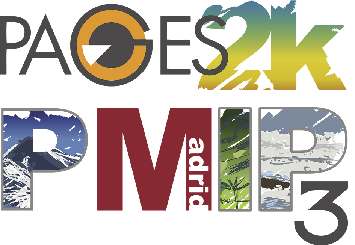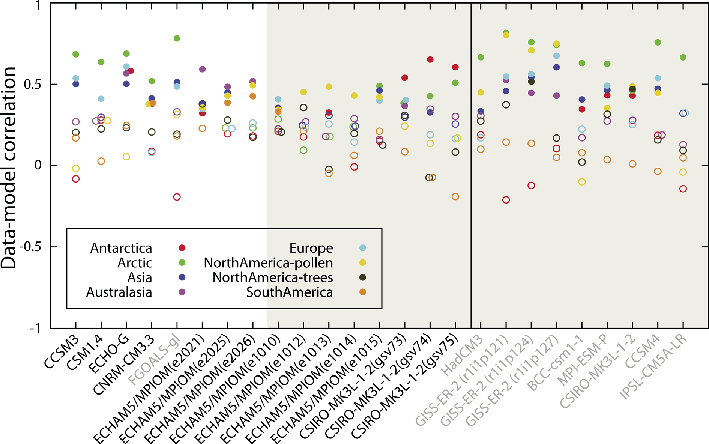- Home
- Publications
- PAGES Magazine
- Integrated Analyses of Reconstructions and Multi-model Simulations For The Past Two Millennia
Integrated analyses of reconstructions and multi-model simulations for the past two millennia
Johann H. Jungclaus, H. Goosse, E. García-Bustamante, L. Fernández-Donado and J.F. González-Rouco
Past Global Changes Magazine
22(1)
44
2014
 |
Johann H. Jungclaus1, H. Goosse2, E. García-Bustamante3,4, L. Fernández-Donado4 and J.F. González-Rouco4
Madrid, Spain, 4-6 November 2013
Comparing model simulations with proxy-based climate reconstructions offers the possibility of improving our understanding of the mechanisms contributing to climate variability and their links to external forcing or internal processes. It helps to identify deficiencies in the way climate variability is represented by proxy records or by model simulations, with implications for future climate change projections. The Past2K group of the Paleoclimate Modelling Intercomparison Project (PMIP3) is promoting model-data comparison activities focusing on the climate of the last millennium. The PAGES 2k Network is fostering similar activities covering the last 2000 years and has promoted the development of regional-scale data syntheses resulting in an ensemble of reconstructions for nearly all the continents (PAGES2k Consortium 2013). The meeting held in Madrid gathered members of both communities with a main focus on comparing the PMIP3 “past1000” simulations with the PAGES2k reconstructions.
Activities started a few months before the actual workshop as most of the 32 workshop participants volunteered to contribute to the analyses of some diagnostics within one of the three working groups (WGs) focused on: 1) PAGES2K regions and PMIP3 simulations; 2) PMIP3 simulations and reconstructed circulation modes; 3) best practices and new approaches in model-data comparison. In addition, participants were identified to prepare reviews. The three-day meeting was structured into review talks (days 1 and 2) and WG presentations (days 2 and 3), allowing time for ample discussion slots. The last day of the workshop focused on discussion and planning future joint activities, including 1) the preparation of manuscripts focused on the comparison of PMIP3 simulations and PAGES2k regional reconstructions, 2) comparison between reconstructed and simulated modes of variability, and 3) on best practices in data-model comparison. Additionally, an outreach event was organized on communicating climate and climate change science.
Several issues from the discussions can be highlighted. For instance, significant correlations between regional temperature reconstructions and climate model simulations (Fig. 1) suggest that, at multidecadal scales and above, regional temperatures respond to external forcing (PAGES2k Consortium 2013; Sundberg et al. 2012; Schurer et al. 2014). The specific fingerprints of volcanic, solar and anthropogenic contributions were analyzed from the perspective of various methodologies, with the role of solar forcing being acknowledged as comparatively smaller. The inter-regional correlations were shown to be lower in the reconstructions than within the models’ world, the latter evidencing a more homogeneous spatial temperature response. The implications of these differences for climate reconstructions and also for the assessment of confidence in climate models were discussed.
The reconstructions of modes of atmosphere and ocean variability such as PDO, ENSO, IPO, PNA, NAO, SAM or the gyre system in the North Atlantic were presented. In most cases, they show very limited resemblance to their simulated counterparts. This suggests an overall lack of evidence for a direct external forcing imprint on the variability of many climate modes. Since internal variability seems to be the dominant factor, model simulations are useful for identifying the dynamics explaining some of the reconstructed changes. However, a more fundamental issue with methodological implications is the limited agreement found in various reconstructions of particular modes. Such inconsistencies may reflect large spatial changes in the positions of the centers of action that are not captured with index definitions based on fixed locations or eigenvector approaches. Here, model-guided mode definition and proxy-site selection (e.g. Lehner et al. 2012) appears to emerge as a promising field of research.
acknowledgements
The organizers thank PAGES, MINECO-FECYT (FCT-13-6276), IGEO and the Asociación Española de Climatología for the funding and/or support that made this workshop possible; E. Lucio for producing the workshop logo; Círculo de Bellas Artes de Madrid and Plataforma Audiovisual UCM for their assistance with the outreach event.
Meeting website: www.palma-ucm.es/members/workshop/Home.html
Outreach event: www.palma-ucm.es/activities/
affiliations
1Max Planck Institute for Meteorology, Hamburg, Germany
2Georges Lemaître Centre for Earth and Climate Research, Université catholique de Louvain, Belgium
3Department of Physics, University of Murcia, Spain
4Institute of Geosciences, CSIC-UCM, Complutense University of Madrid, Spain
contact
Johan H. Jungclaus: johann.jungclaus mpimet.mpg.de
mpimet.mpg.de
references
Lehner F et al. (2012) Quat Sci Rev 45: 85-94
PAGES 2k Consortium (2013) Nat Geosci 6: 339-346

